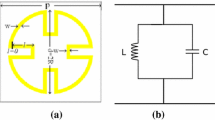Abstract
In this paper a novel low-profile single-layer tri-band frequency selective surface (FSS) unit-cell, which consists of dual concentric modified circular ring, is analyzed and simulated. It can be utilized in the satellite communication systems and electromagnetic shielding applications. The proposed structure has been developed using the modifications in the concentric circular rings FSS in order to obtain the significant percentage of fractional bandwidth and stable frequency response for the perpendicular (TE) and parallel (TM) polarized waves for incidence angles up to 50°. We have also compared the polarization and angular stability performance of the proposed FSS structure with that of the another reported in the literature.
Similar content being viewed by others
References
B. A. Munk, Frequency Selective Surfaces: Theory and Design, 1st ed. (John Wiley&Sons, New York, 2000).
K. R. Jha, G. Singh, Rajeev Jyoti, “A simple synthesis technique of single-square-loop frequency selective surface,” PIER B 45, 165 (2013), DOI: 10.2528/PIERB12090104.
Garima Bharti, K. R. Jha, G. Singh, R. Jyoti, “Azimuthally periodic wedge-shaped metallic vane loaded circular ring frequency selective surface,” IJMWT 7, No. 1, 95 (2015), DOI: 10.1017/S1759078714000488.
A. Qing, C. K. Lee, “An improved model for full wave analysis of multilayered frequency selective surface with gridded square element,” PIER 30, 285 (2001), DOI: 10.2528/PIER00041803.
Dong Ho Kim, Jae Ick Choi, “Design of a multiband frequency selective surface,” ETRI J. 28, No. 4, 506 (2006), DOI: 10.4218/etrij.06.0205.0123.
A. D. Chuprin, E. A. Parker, J. C. Batchelor, “Convoluted double square: single layer FSS with close band spacings,” Electron. Lett. 36, No. 22, 1830 (Oct. 2000), DOI: 10.1049/el:20001308.
J. Romeu, Y. Rahmat-Samii, “Fractal FSS: A novel dual-band frequency selective surface,” IEEE Trans. Antennas Propag. 48, No. 7, 1097 (July 2000), DOI: 10.1109/8.876329.
D. H. Werner, D. Lee, “Design of dual-polarized multiband frequency selective surfaces using fractal elements,” Electron. Lett. 36, No. 6, 487 (Mar 2000), DOI: 10.1049/el:20000457.
A. L. P. S. Campos, T. L. Silva, A. Gomes Neto, “Multiband frequency selective surfaces with simple modification of a rectangular patch element,” Microw. Opt. Technol. Lett. 55, No. 12, 2943 (Dec. 2013), DOI: 10.1002/mop.27951.
R. A. Hill, B. A. Munk, “The effect of perturbating a frequency-selective surface and its relation to the design of a dual-band surface,” IEEE Trans. Antennas Propag. 44, No. 3, 368 (Mar. 1996), DOI: 10.1109/8.486306.
E. A. Parker, S. M. A. Hamdy, R. J. Langley, “Arrays of concentric rings as frequency selective surfaces,” Electron. Lett. 17, No. 23, 880 (Aug. 1981), DOI: 10.1049/el:19810614.
J. Huang, Te-Kao Wu, Shung-Wu Lee, “Tri-band frequency selective surface with circular ring elements,” IEEE Trans. Antennas Propag. 42, No. 2, 166 (Feb. 1994), DOI: 10.1109/8.277210.
Te-Kao Wu, Shung-Wu Lee, “Multiband frequency selective surface with multiring patch elements,” IEEE Trans. Antennas Propag. 42, No. 11, 1484 (Nov. 1994), DOI: 10.1109/8.362790.
M. N. Kawakatsu, V. A. Dmitriev, S. L. Prosvirnin, “Microwave frequency selective surfaces with high Q-factor resonance and polarization insensitivity,” J. Electromagnetic Waves Applications 24, No. 2-3, 261 (2010), DOI: 10.1163/156939310790735741.
N. Papasimakis, Y. H. Fu, V. A. Fedotov, S. L. Prosvirnin, D. P. Tsai, N. I. Zheludev, “Metamaterial with polarization and direction insensitive resonant transmission response mimicking electromagnetically induced transparency,” Appl. Phys. Lett. 94, No. 21, 211902 (2009), DOI: 10.1063/1.3138868.
V. Dmitriev, S. Prosvirnin, V. R. Tuz, M. N. Kawakatsu, “Electromagnetic controllable surfaces based on trapped-mode effect,” Advanced Electromagnetics 1, No. 2, 89 (2012), DOI: 10.7716/aemv1i2.109.
C. Guo, H.-J. Sun, X. Lu, “A novel dualband frequency selective surface with periodic cell perturbation,” PIER B 9, 137 (2008), DOI: 10.2528/PIERB08071302.
Garima Bharti, K. R. Jha, G. Singh, R. Jyoti, “Design of angular and polarization stable modified circular ring frequency selective surface for satellite communication system,” IJMWT (Mar. 2015), DOI: 10.1017/S1759078715000331.
Garima Bharti, K. R. Jha, G. Singh, R. Jyoti, “Angular stable, dual polarized and multiband modified circular ring frequency selective surface,” Frequenz 69, No. 17, 199 (Mar. 2015), DOI: 10.1515/freq-2014-0067.
Inder Bahl, Lumped Elements for RF and Microwave Circuits, 1st ed. (Artech House, London, 2003).
Y. Yang, X.-H. Wang, H. Zhou, “Dual-band frequency selective surface with miniaturized element in low frequencies,” PIER Lett. 33, 167 (2012), DOI: 10.2528/PIERL12070319.
K. Delihacioglu, S. Uckun, T. Ege, “Scattering characteristics of FSS comprised of L-shaped and one-turn helix shaped conductors for TE and TM excitation,” Electrical Engineering 89, No. 3, 177 (Jan. 2006), DOI: 10.1007/ s00202-005-0335-x.
A. Pekmezci, T. Ege, “Scattering characteristics of FSSs with triangular conducting elements,” Electrical Engineering 96, No. 2, 145 (June 2014), DOI: 10.1007/s00202-013-0281-y.
Cheng-Nan Chiu, Wen-yi Wang, “A dual-frequency miniaturized-element FSS with closely located resonances,” IEEE Antennas Wireless Propag. Lett. 12, 163 (2013), DOI: 10.1109/LAWP.2013.2245092.
Author information
Authors and Affiliations
Corresponding author
Additional information
Original Russian Text © G. Bharti, K.R. Jha, G. Singh, R. Jyoti, 2015, published in Izv. Vyssh. Uchebn. Zaved., Radioelektron., 2015, Vol. 58, No. 11, pp. 3–13.
ORCID: 0000-0002-5159-3286
The authors are thankful to the Indian Space Research Organization vide Project No. ISRO/RES/4/579/10-11.
About this article
Cite this article
Bharti, G., Jha, K.R., Singh, G. et al. Planar tri-band frequency selective surface with transmission in S-band and reflection in Ka/Ku-band. Radioelectron.Commun.Syst. 58, 479–486 (2015). https://doi.org/10.3103/S0735272715110011
Revised:
Published:
Issue Date:
DOI: https://doi.org/10.3103/S0735272715110011




